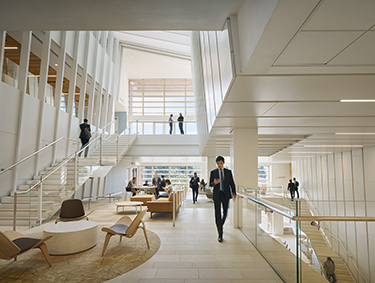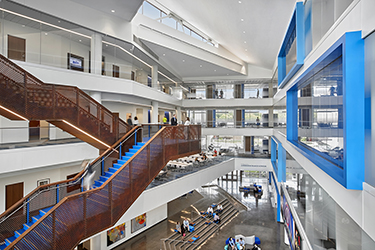|
Subscribe / Renew |
|
|
Contact Us |
|
| ► Subscribe to our Free Weekly Newsletter | |
| home | Welcome, sign in or click here to subscribe. | login |
Architecture & Engineering
| |
 |
April 15, 2021
The post-pandemic educational learning curve
Gensler Seattle

Barry
|
When the world came to a screeching halt a year ago, little did we know how much would change in our daily routines in how we work, in how we live and in how we learn. The pandemic forced our teachers, students, parents and educational institutions to adapt to new, fast-tracked, hybrid and remote learning models that hadn’t existed at such a scale before.
Within a short time, we’ve experienced an unprecedented shift and are now looking at lessons learned and reimagining what a more resilient and equitable education system could look like moving forward.
We at Gensler recently published our design forecast for the year ahead, exploring trends, insights and advice on how we can address the tactical challenges brought on by the pandemic. Following are some of the trends we foresee continuing post-pandemic:
HYBRID LEARNING
Providing a choice between virtual and physical learning environments is critical in supporting equal access to seamless digital and physical experiences. Hybrid academic environments must be adaptable to support every learner, while keeping up with constant change. Single-use spaces will be a thing of the past, and instead will have multiple lives as they evolve and adapt.
DESIGN TO THE EDGES
Institutions must move away from designing one optimal experience for all students and instead focus on designing multiple, diverse pathways so every learner is welcome and feels a sense of belonging.
TALENT DEVELOPMENT
The repositioning of the talent pool toward marketable and adaptable skills is accelerating. To drive economic vitality, education is taking cues from industry to incubate talent and boost job placement. The emergence of unlikely collaborations across fields of study, industries and departments has expanded the definition of interdisciplinary culture and will better equip institutions to tackle complex challenges operationally and academically.
DATA INFORMED
As competition for students and funding increases, institutions are focused on measurable success and impact. A focus on the user experience facilitates an increase in resource allocation, enhancing opportunities for student and faculty recruitment and retention, grants, funding, academic performance and partnerships.
RESILIENT CAMPUS + COMMUNITIES
The campus is no longer an isolated bubble. The triple bottom line for educational institutions — social, economic and environmental — will require a holistic approach to resilience related to sustainability, wellness, and operational and technological preparedness.
VALUE OF PLACE
Virtual access to knowledge continues to evolve, but in-person experiences are essential for cognitive skills, social and emotional relationship-building, and igniting inspiration. As learning moves online, in-person experiences and culture must be even more impactful for students connecting with each other, faculty and the larger world context.
As we continue to explore possible solutions for an evolved academic system, the key element connecting all these potential solutions — and quite honestly, the most important — is the student. While teachers and parents are certainly grappling with a myriad of challenges themselves, students are the most impacted and will experience the most lasting effects, whether to their social, emotional or physical well-being.
When we finally are living in a post-pandemic world, how can we future-proof our schools so we are better prepared for the next pandemic or societal challenge? How can we evolve the design of our schools to enhance the student experience and foster learning and success? After spending months studying the shifting space needs at colleges and universities during the pandemic, Gensler identified four key design strategies that are shaping the next generation of campus buildings:
COMMUNITY
Campuses must support the “whole student” and prioritize programs that target physical, social and emotional well-being. Providing spaces to support interaction and collaboration and locating services to maximize visibility and accessibility are paramount. A combination of digital platforms integrated with physical space will bring the most value for human connection and enhance the learner’s sense of belonging.
MULTIDISCIPLINARY INCUBATORS
Academic incubators and interdisciplinary spaces support entrepreneurship. These environments and support networks will continue to evolve and will be even more vital to diversify the economy and provide an engine for growth in the community. Spaces that bridge industry and academia and fuel workforce development, R&D, and innovation will continue to pervade education.
TECH-ENABLED COLLABORATION AREAS
Despite advancements with online communication and whiteboarding programs, face-to-face collaboration sessions are still supreme. Academic buildings will transition into places of gathering, where groups can meet, learn and create together. Flexible space supports dynamic, in-person collaboration. These hyper-flexible and tech-enabled learning environments provide choice based on how learners and educators best engage between virtual and physical space.
REIMAGINED LECTURE FORMATS
“Flipped classrooms” started trending from a unique question: Why pull students together in a 1,000-seat lecture hall to sit in a non-interactive environment when you can record (or live broadcast) it, and have those students instead listen to the lecture from their dorm room and use alternating class periods for smaller, in-person groups? The shift to remote learning places a renewed focus on repurposing lecture halls into collaborative environments, hyper-personalizing hands-on learning in smaller cohorts.
As we see more schools, colleges and universities begin reopen — in whatever potentially new hybrid manner that may be — we must leverage the learnings from this past year and recognize and course correct the dire shortcomings that were exposed. Society has never been so widely aware of the challenges surrounding equitable learning as we are right now. While we wait to see how our academic system will evolve post-pandemic, it’s critical that focus is placed on ensuring our students all have equal access to the same spaces, tools and technologies. After all, we are teaching our future leaders. It’s time for academia to evolve to meet every student at the same equitable starting point. We can’t afford to fall behind this learning curve.
Donna Barry is an architect, design director, senior associate and higher-education practice area lead for Gensler’s Seattle office.
Other Stories:
- Seattle’s U District housing boom: is there room for it?
- Sourcing regional materials for higher ed
- New design requires thoughtful programming
- Early-stage design helps Hermanson with UW center
- How to make master plans that work
- The evolution of campus, a new normal for higher education
- Sustainable student housing building design for higher education
- The evolving building delivery models at higher education institutions




